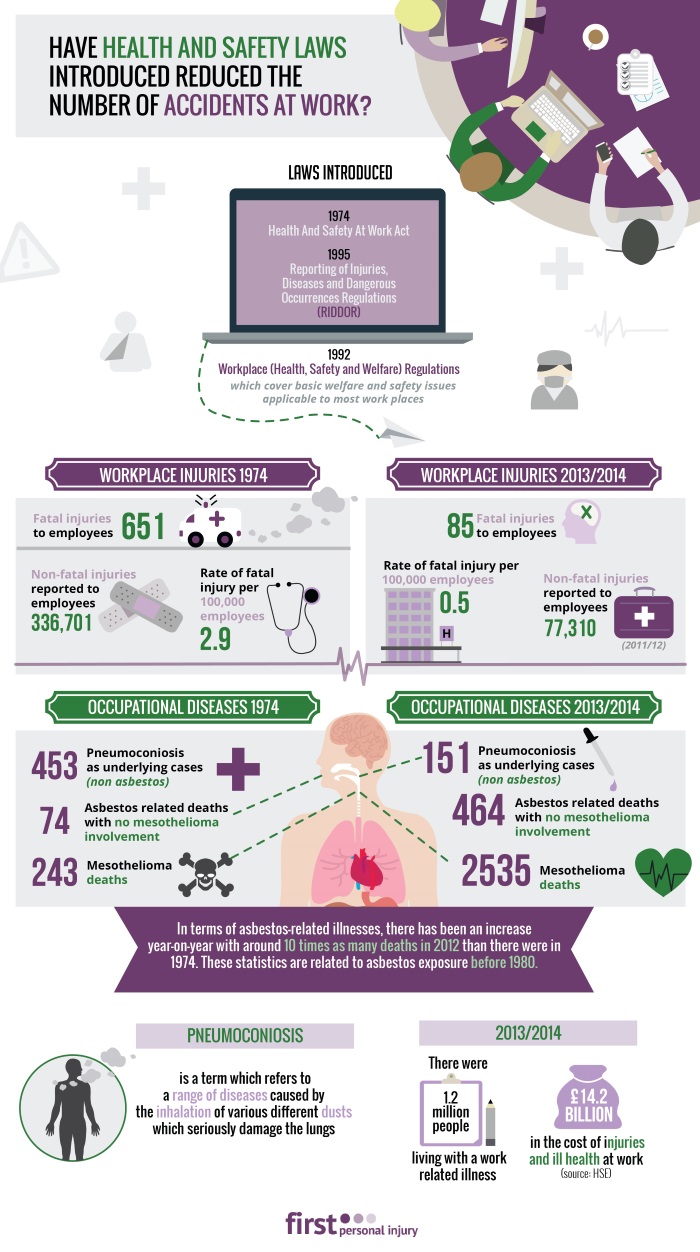This website uses cookies so that we can provide you with the best user experience possible. Cookie information is stored in your browser and performs functions such as recognising you when you return to our website and helping our team to understand which sections of the website you find most interesting and useful.
... because we understand

Have Changes In Health And Safety Laws Had An Impact on Work Place Safety?
Once upon a time, there were no health and safety laws in the workplace. Hard to believe isn’t it? Yet there was a time when accident books, protective clothing and Health and Safety Inspectors did not reside in, visit or occupy filing cabinet space in our chosen place of occupation.
Fast forward from that by-gone era when there were around 8 million employees who had no legal safety protection while at work, to the seventies, when the Health and Safety at Work Act 1974 was passed through parliament.
The HSAWA was considered to be an audacious step in terms of legislation and was famously quoted as being ‘bold and far-reaching’ by the first Health and Safety Executive Director General. So has the Act and other ensuing health and safety laws proven to be the work-safe game-changer it promised to be 40 years ago and have the number of accidents at work decreased thanks to its introduction?
The Health And Safety At Work Act 1974 Has Brought About Change
The simple answer to whether or not the Act has had an impact on workplace accidents is a firm, ‘yes’. There is no doubt that this piece of historic legislation has not only directly prevented accidents through its guidance and codes of practice, it has also cultivated a shift in attitude and behaviours of workers and employers which, although perhaps less quantifiable, still contributes to an improvement in safe working cultures in the UK.
It’s important to remember that in the 1970s when the HSAWA was first founded, that the landscape of working Britain was notably different from what it is now. More people worked in factories, meaning that machinery accidents were more prolific than they are at present. Similarly, a large portion of the workforce is office-based today which has brought about a new assortment of occupational illnesses such as stress-related conditions.
The above factors do influence the incidence of work-related illnesses and accidents; the HSE itself suggests that half of the reduction in non-fatal injuries at work in 2012 can be attributed to a change in employment patterns.
The Development of Health and Safety Law
The HSAWA has not been stagnant since it started and progress is constant. There have been numerous other laws which have been passed through parliament in relation to the Act, this includes:
- Reporting of Injuries, Diseases and Dangerous Occurrences Regulations 1995 ( RIDDOR). Laws which put duties on persons in control of a work premises to report certain accidents and illnesses as well as near miss accidents.
- The Control of Substances Hazardous to Health (COSHH). This law requires employers to ensure employees are safe from harm of hazardous substances.
- Workplace (Health, Safety and Welfare) Regulations 1992 which cover basic welfare and safety issues applicable to most workplaces.
Despite the other influences on the number of accidents and injuries at work before the Act, the difference in numbers of accidents and diseases at work between the 1970s and present day are self-explanatory:
Statistics – Workplace injuries
| Injury type | 1974 | 2013/14 |
|---|---|---|
| Fatal injuries to employees | 651 | 85 |
| The rate of fatal injury per 100,000 employees | 2.9 | 0.5 |
| Non-fatal injuries reported to employees | 336,701 | 77,310 (2011/12) |
Statistics – Occupational Diseases
| Occupational Disease Type | 1974 | 2013/14 |
|---|---|---|
| Pneumoconiosis as underlying cases ( non-asbestos) | 453 | 151 |
| Asbestos-related deaths with no mesothelioma involvement | 74 | 464 |
| Mesothelioma deaths | 243 | 2535 |
*Pneumoconiosis is a term which refers to a range of diseases caused by the inhalation of various different types of dust which seriously damage the lungs.
Further HSE Stats
The HSE also reports that stress-related conditions have dropped since the 1990s which it says can be credited to changing attitudes affecting reporting levels. In addition, it states that musculoskeletal disorders have also dropped since the 1990s.
In terms of asbestos-related illnesses, there has been an increase year-on-year with around 10 times as many deaths in 2012 than there were in 1974. These statistics are related to asbestos exposure before 1980.
According to the HSE website, in 2013/14 there were 1.2 million people living with a work-related illness; 133 workers killed at work with an ultimate cost of £14.2 billion in the cost of injuries and ill health at work. Clearly then, there is still some way to go in terms of Health and Safety.

This information has been sourced from the HSE website.
Sources: http://www.hse.gov.uk
Had An Accident Or Injured In The Workplace?
If you’ve had an accident or been injured at work, First Personal Injury may be able to help you to make a claim for compensation.
Use our online form to contact First Personal Injury and a member of our expert team will call you back. Alternatively, get in touch on 0800 808 9740 to discuss your prospective accident claims case in more detail.
Accidents At Work Claims Types
Here at First Personal Injury, we deal with a wide range of accident at work claim types, some of which are listed below. If you have been injured in the workplace from some other type of occurrence, please do not hesitate to contact us anyway, as we may be able to help and advise regarding your claim for compensation.
- Chemical Leaks
- Commercial kitchen accidents
- Construction site accidents
- Workplace slips trips and falls
- Factory accidents
- Accidents involving falling objects
- Lack of training
- Head injuries at work
- Office accidents
- Chronic pain injuries
- Falls from height
- Falls from ladders
- Eye injuries at work
- Back injuries at work
- Electrical accidents in the workplace
- Manual handling claims